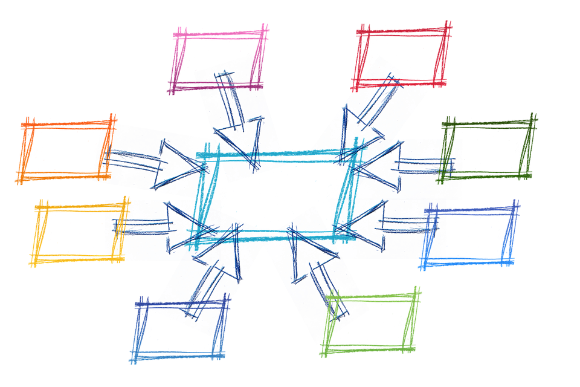By Tim Waddington and Riley Hill
In case you missed it, there’s a bright and shiny new path being forged in curriculum studies both here in British Columbia and in several jurisdictions across the developed world. Premised in student-centric, postmodern and constructivist thought, the notion of Concept-Centered curriculum and instruction has gained traction in response to immeasurable swaths of instantaneously accessible knowledge, the ubiquitous personal use of technology amongst students and resulting de-legitimization of privilege regarding what, heretofore, were considered unassailable narratives of cultural truth.
Some educators love this new path (already), some don’t understanding it (yet), and some are proving quite resistant (still). To understand the resisting element – and with due sympathy – perhaps we will find it helpful to tell an edifying narrative. That, …and Imaginative Education simply loves good storytelling as a key component of emotionally engaging teaching and learning. The story is an old one, coming from the field of sociology and corporate studies, involving five monkeys locked in an enclosure with a pyramid of steps or large boulders placed in the center.
 Turns out, it’s a pretty regular monkey day, what with the usual grooming behaviours and the hearing, seeing and speaking of no evil. But just then, a banana is lowered on a wire high above the pyramid of stones, at least until one industrious anthropoid sees the forbidden fruit and recollects that bananas hold a certain if unspecified appeal. Off he goes northward and the other monkeys soon enough follow until *wham!* the zoo-keeper unleashes hoses of ice-cold water on all five monkeys, not unlike in that terrible scene with Draco Malfoy in the equally terrible, Planet of the Apes.This scenario is repeated numerous times, with all the repetition of Mythic Understanding, so much so that the monkeys eventually figure out the patterns and begin to attack any one of their furry number engaging in individualistic bright ideas. Surely, an insidious act of self-censure within a disciplinary society.
Turns out, it’s a pretty regular monkey day, what with the usual grooming behaviours and the hearing, seeing and speaking of no evil. But just then, a banana is lowered on a wire high above the pyramid of stones, at least until one industrious anthropoid sees the forbidden fruit and recollects that bananas hold a certain if unspecified appeal. Off he goes northward and the other monkeys soon enough follow until *wham!* the zoo-keeper unleashes hoses of ice-cold water on all five monkeys, not unlike in that terrible scene with Draco Malfoy in the equally terrible, Planet of the Apes.This scenario is repeated numerous times, with all the repetition of Mythic Understanding, so much so that the monkeys eventually figure out the patterns and begin to attack any one of their furry number engaging in individualistic bright ideas. Surely, an insidious act of self-censure within a disciplinary society.
Why is it always fruit?
Because the pattern grows so engrained, the substitution in and out of individual monkeys makes little difference. New monkey, same result. Having participated in the original scene or not, each will soon continue acting according to group expectations, attacking any monkey who acts contrary to the mere perception of group norms. Even when all the original monkeys are long since gone – hopefully to better living situations, we might add – the norms, expectations of conduct and general modus operandi will carry on unperturbed. “Why must we ignore that delicious banana?” “Don’t quite know.” “But it’s so ripe!” “That’s just the way things are.” “Why can’t we go outside?” “Them’s the rules, I guess.” “Why are we still assigning marks?” “Ask me no questions, I’ll tell you no lies.” This is how bureaucracy – schools, for example – operate. And, this is path dependence, a most useful sort of notion for explaining any resistance to Concept-Centered Curriculum and Instruction.
Path Dependence as an Example of Concept-Centered Instruction
Path dependence is a construct common in the study of economics and history. As in the monkey sphere, it suggests that the decisions we make today are influenced by the choices we collectively made yesterday, whether anyone intended for a connection between the two or not. The concept emphasizes the importance of human decisions in shaping our world and our inability to predict the consequences of our actions fully. Moreover, it demonstrates how people act in the world while also taking into account the momentum, or inertia, of historical and material conditions. Path dependence demonstrates how while we are free to act and make decisions in the present, we are also tethered both materially and historically to the decisions and directions afforded by our collective past. We are, in this sense, continually conditioned to continue the continuous conditioning of our continuous conditions. The concept explains why we often persist with actions that, looking from the outside, seem unwarranted, maladaptive and oftentimes, irrational. Looking through the lens of path dependence, three paradoxical elements emerge: (i) we are free to act and make choices, (ii) all of our decisions have unintended consequences, and (iii) we are all more or less bound by history.
Here’s a real-life example. After the Second World War, city planners decided that Houston would be a suburban city, meaning its citizens would live in detached homes and rely on personal vehicles for transportation. At the time, this decision made terrific sense. The economy in post-war America was booming, oil was abundant, and cars were both cheap and reliable. We had not yet grasped our negative ecological impact on the planet, and owning a private home and automobile symbolized American freedom and prosperity.

The future seemed bright and, fondly remembering The Jetsons, without limit. But then, as time passed, we learned about the unintended consequences of suburban communities, in particular, upon the environment. In the face of climate change and overconsumption, many residents of Houston came to realize with a resounding “Y’all” that it was better for citizens to live in denser communities, making use of relatively inexpensive public transportation powered by renewable electricity. Viewed through the concept of path dependence, the challenges seem obvious. Houston’s infrastructure was designed for personal transportation and the sprawl of suburban housing. The costs of making necessary environmental adjustments to infrastructure are massive.

While this does not mean that Houstonians are forever stuck with their cars, pickups and downtown interstate highways, the situation clearly demonstrates how the cost and viability of today’s preferred choices, even the possibility of enacting them, are profoundly impacted by the values and decisions of yesterday. The post-war decisions made to facilitate the adjustments of returning GIs and foster the growth of young nuclear families continue to influence today’s policy makers and city planners, just as the choices made today will carry unintended consequences, some of which we cannot even anticipate at this point, long into the future.
Here’s another example with a different treatment of path dependence, this time regarding the legacies of racism. Most people now consider it a truism that race is a social construct and there is no substantive congenital difference between one “race” and another. With this in mind, it’s tempting to think we can just forget about the history of racial divisions and so, simply move on with life. The problem remains, however, that even if we sincerely wish to move past these racial divides, we nevertheless made harmful decisions in the past premised upon a belief in spurious racial hierarchies. For privileged groups, racial hierarchies meant access to property, status and the institutions that allowed them to build lives of security and wealth. For oppressed groups, racial hierarchies meant the denial of all these things. Collectively, we remain accountable for these choices precisely because they continue to shape the lives of both individuals and whole communities today. We can, in keeping with our freedom to act and begin anew, make decisions today about how to deal with the “racialization” of groups, but we are not, and will never be, starting from scratch. The decisions we make today are intimately bound to the material realities created by what we chose yesterday. And while we are free to choose whatever we like going forward, we cannot break our chains, both metaphorical and literal, to the past without running headlong towards the three-headed Chimera of denial, dissimulation, and self-delusion.
The Concept of Concept-Centeredness
Concept-Centeredness is easy enough to understand.
At its core, concept-centeredness asks educators to consider concepts, ideas, diagrams, events, people, values, works of art, etc. as lenses through which students may think about and, subsequently, inquire about the world and their place in it.
A previous post here on imaginED, titled “Aristotle and a Leather Jacket”, depicted a re-reading of S.E. Hinton’s classic novel The Outsiders through the concept of Friendship. There, we saw how the numerous relationships of the characters fell, more or less neatly, into three qualities of friendship, specifically as utility, as pleasure, as virtue. We also saw that such a concept-driven treatment of the novel opens up brand new vistas, hermeneutically connecting the student to the text, to other texts, the world, their friendships and, most importantly, themselves.
The temptation, of course, is to claim something like the following: “Surely, beginning with an exploration of a concept as a concept lends itself to Philosophic kinds of understanding but less so to earlier Romantic, Mythic and Somatic forms.” (Wondering what kinds of understandings are? Read this post.) It’s a good question, even if we did ask it ourselves. (Go us!)
An appropriate response, it seems to be reasonable to suggest, is to direct our attention to the treatment of what one might mean by concept, particularly as something less than definitive and solid, but rather something closer to a tool or a lens which enables thinking, inquiry, learning and the construction of knowledge. Exploring ‘Dance’ allows us to use rhyme, rhythm and pattern while ‘Balance’ allows us a metaphor for understanding not only physicality, but also the categorization of items and a beginning sense of numeracy, … all contained within Mythic Understanding. ‘Hunger’, ‘Symbiosis’, ‘Infinity’, ‘Culture’ and ‘Courage’ each speak to the various tools of Romantic Understanding. Greater abstractions such as ‘Classical Liberalism’, ‘Structuralism’, ‘Phagocytosis’, and ‘Casuistry’ can arrive later, with more properly achieved Philosophic and Ironic Understanding. Considered broadly and with some sympathy, concepts can themselves become powerful tools for thinking and learning. This is why Imaginative Education insists that kinds of understanding can be deployed across the curriculum at every grade level in intellectually rigorous and emotionally honest ways.
Patience, Monkeys! Patience
Changes to curriculum and instruction such as our current shifts in orientation towards Concept-Centeredness and Inquiry, are necessarily challenging, complex and time-consuming undertakings. Like the giant tankers and container ships that populate Vancouver Harbour, curriculum is built of slow-moving vessels that are difficult to turn in tight waters. Metaphors – whether of ships or of bureaucratic dogmas or of constructivist conceptions of knowledge – gain popular acceptance and grow normalized through the many sedimentations of habit, practical implementation, and reinforcements provided by the execution of authority. Still, be clear: metaphors they are and as such, reside with you to enact or further or frustrate.
 What we hope to provide here is a supportive example for how models of ‘new’ curriculum might be set in motion in ways that are emotionally engaging, imaginatively interesting, and likely to support permanent gains in student learning and the development of mind. Our best advice – if you’re open to accepting advice, that is – is to ignore the monkeys set on throwing shoes, old bits of chalk, tired lesson plans, and other more sordid bits and pieces monkeys are wont to throw when distressed. Concept-Centeredness, and Concept-Centered Inquiry – coming soon to an Amazon near you – are likely here to stay with good reasons. An imaginative approach to the deployment of concepts helps us along some distance.
What we hope to provide here is a supportive example for how models of ‘new’ curriculum might be set in motion in ways that are emotionally engaging, imaginatively interesting, and likely to support permanent gains in student learning and the development of mind. Our best advice – if you’re open to accepting advice, that is – is to ignore the monkeys set on throwing shoes, old bits of chalk, tired lesson plans, and other more sordid bits and pieces monkeys are wont to throw when distressed. Concept-Centeredness, and Concept-Centered Inquiry – coming soon to an Amazon near you – are likely here to stay with good reasons. An imaginative approach to the deployment of concepts helps us along some distance.
To venture one last metaphor, the gifts of Imaginative Education are most abundant way out on the skinny parts of the branch where many monkeys either cannot, or dare not, reach out. To do so involves a certain portion of risk and danger, because first we need to let go of the tree trunk, grounded to the earth with its ancient lineage of ideas and legacies of traditional practice. Those who want or need to cling to the thicker and safer branches are in no respects either ‘wrong’ or ‘bad’ or ‘inferior’. But waaaaay out there on the edge, growing ripe and sweet in the fulsome sun, the rewards…THE REWARDS TO BE FOUND!!!



NOTE BY THE AUTHOR: In defence of direct instruction. Without writing a post about our own post, it is probably worth mentioning that there remains a place for direct instruction both within IE and the ‘new’ inquiry model. Just as we cannot ‘be imaginative’ without having grist for the mill, neither may we fairly expect students to ask powerful questions of inquiry without letting them in on the current field of knowledge. This implies CONTENT, and lots of it … a topic for future posts.
One might, while I have you, question the monkey motif. One of my trusted mentors at SFU used to routinely tell me “all we are is hairless apes”, a phrase I used to value very much everytime I got a little ahead of myself or took myself too seriously. I quite enjoy monkeys, not because of their capacity for high literacy, sense of mission, or advanced moral development of course; these are the domain of human beings proper, particularly we might add, that subspecies we commonly call teachers. Still monkeys enjoy this particular advantage, that they do not appear terribly burdened by the presence of abstractions, identifying labels, or other metaphors which so often shape our Human, All Too Human lives. Reading and writing charitably, I would suggest it a mistake to import any evolutionary sensibility to the post. Neither monkeys nor humans are ‘better’ in any ultimate sense. Likewise, neither traditional, progressive nor inquiry are universally better for every student in every setting…but they are DIFFERENT and it is these differences which are worth pulling apart to understand their relative challenges and merits.